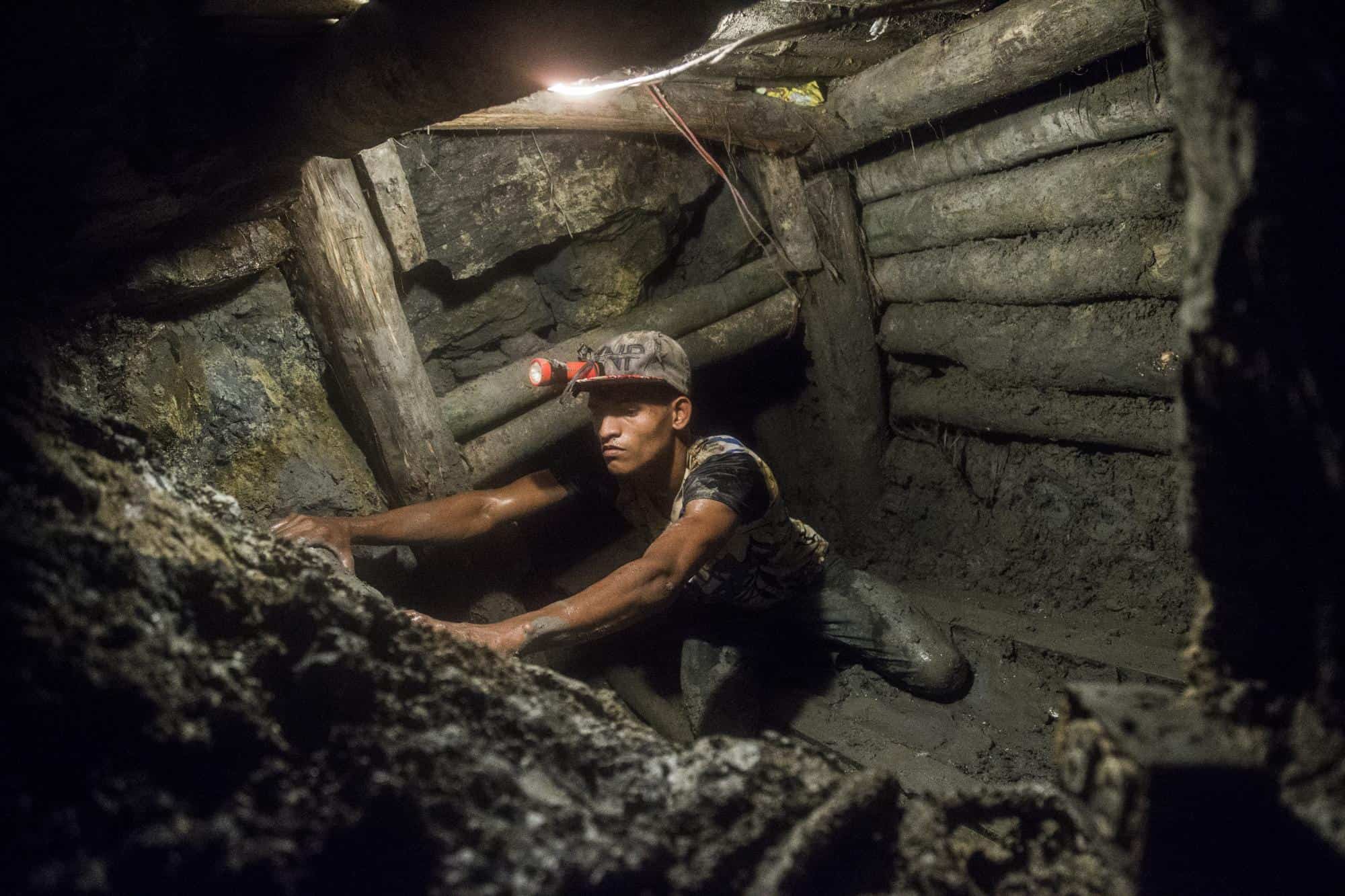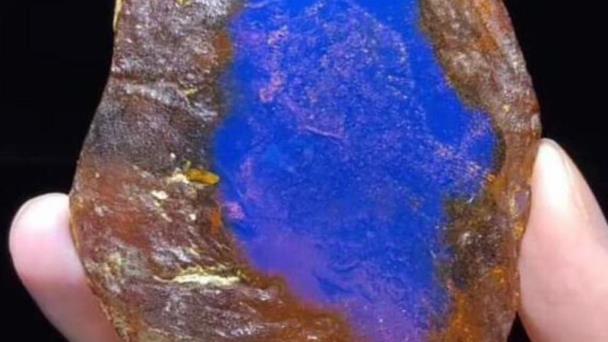For a year now, Divaris Cruz has kept amber blue extracted from an underground mine in La Cumbre, Santiago. He is holding it in the hope that it will trade as high as it did five years ago in a market that is plummeting in price, rate of extraction and jobs.
Cruz chairs the Cooperative of Producers of Amber of the Summit. The blue pieces are priced at about 30,000 pesos, but five years ago they were worth five times more. The inventory of it, which also composes it amber of lower categories, estimates it at 600 pounds. Years ago everything would be worth between 15 million and 22 million pesos, but now they would offer him about 3 or 4 million pesos.
Between 2014-2016 there was a boom in the cottage industry of the amber Dominican, a resin used for making jewelry and decorative elements. They were “the best years in the history of the extraction of amber” Creole because of the interest -mainly from the Chinese market- in its quality and tonalities, remembers Uladislao Lora,
But the non-appearance of samples with the quality increasingly demanded by buyers, the collapse of prices and the prohibition in force since 2016 to export amber and larimar (a variety of pectolite only found in Quisqueya) in its natural state, raw and semi-processed, has affected extractors, as they sold the pieces to a foreign market that values them more raw.
“The Dominican amber they (the Chinese) said was the diamond of the Caribbean”Director of Artisanal Mining
Six years ago, the Ministry of Energy and Mines banned by resolution the foreign trade of amber in its natural state, raw and semi-processed, so that it is only processed. With this, it sought to regulate its export to maintain national control criteria, reserve levels, quality standards and certification. In addition, encourage the hiring of local labor and develop artisanal MSMEs.
But in 2018, the same ministry had to issue another resolution in which it granted six months to export up to 80% of the amber and larimar stored by extractors as a result of the 2016 provision, regardless of their status, to boost the mining handicrafts in international markets.
And now Energy and Mines has a new resolution in the final draft phase that would lift a large part of the ban, allowing it to be exported semi-processed and processed, with the aim of benefiting artisans and miners who seek to build a small industry in the amber which, at its peak, was the source of direct and indirect employment for more than 3,000 people.
“Here (in Santiago) there are only two mines that are working at 10 percent. If they had 10 holes –for example–, they have a hole”, says Cruz. “The market is practically nil.”
“Those pieces (the blue ones) are among the last to appear of first quality and have not been able to be sold because the price paid to the miners is well above what they are offering,” he says.
goodbye to the bonanza
The amber It is a fossilized resin of plant origin. The greatest wealth for exploitation is found in the Baltic region of Eastern Europe and the Mediterranean, in some states of Mexico and in the Dominican Republic.
In the municipality of El Valle, in Hato Mayor, and in La Cumbre are the main points of extraction of amber Dominican. Lora points out that an ounce that used to cost between 100,000 and 150,000 pesos has dropped to 20,000 and 25,000 pesos. “And that’s not attractive to them (extractors) anymore,” he says.
According to research, the age of the Dominican exceeds 15 million years and stands out for its quality. Blue is the most precious and expensive, due to its rarity. Other variants of less value have shades of cognac, yellow, red, green, black or colorless.
“The amber Dominican they (the Chinese) said it was the diamond of the Caribbean”, he comments. “An ounce of amber blue cost much more than an ounce of gold in the year 2014, 2015, 2016”.
But Chinese buyers began to demand a amber of higher quality, especially blue, but it no longer appeared in the same quantity, Lora recalls. “At that time he began to reduce the production of amber and the Chinese stopped coming to capture it,” he says.
Carlos Gómez, one of the largest extractors of amber in El Valle, indicates that currently operating costs are higher than profits. “Those who made the effort to get the mines to produce were the Chinese, when the Chinese were buying. When the Chinese leave here (there were investors who settled in the town), they are hardly buying, production has dropped and everything has dropped, ”he laments.
Among the current buyers are the same extractors from Santiago, who store the resin waiting for a better price and for its export to be allowed, and local artisanswhich are not enough to acquire the entire production.
“And now (the situation) is going to get worse,” says Gómez, referring to the damage left by Hurricane Fiona in El Valle, which caused holes to be clogged through which it is extracted. amber.
In 2017, Free Journal watched the continuous rise and fall of muddy men who were lost in the depths of the subsoil to extract amber in the open holes at Siete Cañadas, the mine of amber largest and most productive of the Yanigua formation, which runs from Los Haitises to El Cabao and El 20 on the Hato Mayor-El Valle highway. (To read the report published at the time and watch a video about what it’s like inside the mines of ambermake click here).
Lora estimates that between 2014-2016 there were about 600 holes or wells in El Valle, where approximately 2,500 extractors or amberos –as they are called- were concentrated and had this activity as a source of employment. “Where there could be 400 or 300 holes and 1,500 people, do you know how many holes there are? Two holes and 40 men,” she says.
Among those who were dedicated to the activity, there are those who migrated to agriculture and the service sector.

Resolution: Salvation?
Since last year, the Ministry of Energy and Mines is working on the draft of a resolution that would help the recovery of the mining of amber and larimar. But its publication has been delayed due to accidents recorded this year –among these fatalities– in the Larimar mining area, in Barahona. On Thursday of last week, restructuring work in the area formally began with a view to reducing risks and boosting operations in the short term.
“As we had the (larimar) mine paralyzed, we did not want to open the door to exports at a time of paralysis and for our artisans to feel limited in obtaining their larimar,” says Golye Latoufe, head of the Mining Promotion Department of the Ministry of Energy and Mines.
Meanwhile, Latoufe overtakes Free Journal that with the resolution pending, certificates of no objection will be reissued to allow the export of amber and semi-processed and processed larimar.
The amber semi-processed is one that has been cut into different sizes and processed is when they are presented in cabochons, that is, as polished natural stones and not convexly carved, according to customs definitions.
Already since January 2022, some tariff codes contained in the seventh amendment of Customs for the export of amber and larimar. In the upcoming resolution of Energy and Mines, it is not contemplated to allow crude exports as miners have requested.
“The way it works now is especially disadvantageous for the miners and all the advantage for the artisans, which is what we see. The miners tell me: while we have the export ban, we have to sell our material at the price that the artisans tell us, because we have no other option,” says Latoufe.
“It’s a bit of balancing the balance -he adds-, so that there are advantages for the artisanal sector, but also for our miners.”








